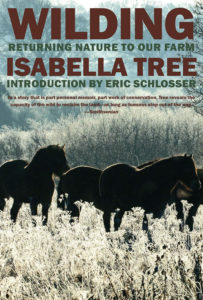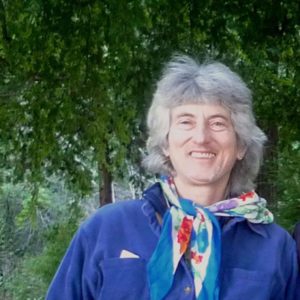Review of Isabella Tree’s “Wilding: Returning Nature to Our Farm”
 On ancestral land now called Knepp, in West Sussex, England, Isabella Tree and her husband Charles Burrell traveled a long, winding – and very rewarding – path back to the future, as it were. From a wild location for medieval aristocratic hunting, the land was enclosed for agriculture in the late 16th century. It passed through a variety of owners, culminating with the Burrell family.
On ancestral land now called Knepp, in West Sussex, England, Isabella Tree and her husband Charles Burrell traveled a long, winding – and very rewarding – path back to the future, as it were. From a wild location for medieval aristocratic hunting, the land was enclosed for agriculture in the late 16th century. It passed through a variety of owners, culminating with the Burrell family.
In “Wilding: The Return of Nature to a British Farm,” Isabella describes their journey from struggling farmers to pioneers in the rewilding movement.
Their late 20th century farming predicament is a familiar one: Their dairy and row crops were no longer financially sustainable, and they found themselves squeezed between dairy consolidation and the side effects of chemical farming on their clayey fields.
Desperate, they took a leap of faith and tried wilding – the practice of letting plants in an area grow uncultivated – on their 3,500 acres. Isabella prefers the term “wilding” to “rewilding” because she notes we can never truly return the land to how it was. Rather, we must chart a new path to a stable biological future for the flora and fauna.
In Britain, Isabella describes the backdrop of their project as a landscape where various wild species had gradually disappeared since the end of World War II, largely due to intensive agriculture.
To change course on their land, a first step was removing industrial equipment. Soon after, they sowed a native wildflower meadow and installed a 6-foot deer fence around 370 acres.
They stopped plowing and brought in fallow deer to graze the pastures and shrubbery while also fertilizing them. They also let dead trees and animals decay in place. “But the biggest change of all,” Isabella writes, “came from simply not drenching the land with fungicides and pesticides, as we have since the 1960s.”
Insect populations exploded, then bird species began to return, as well as bats and mushrooms. As the couple let nature take over, they were delighted when rare and imperiled species – like turtledoves, nightingales and many others – appeared. Luck, timing and the goodwill of many helped in their success.
Reading about the couple’s efforts, we learn that bureaucratic boggles, adroit choices and assiduous networking are all part of the process of restoring the land to itself. At first, Isabella says neighboring farmers were skeptical – myths of the dire, dark forest and of what modern farming entails are tenacious.
Not long after starting their wilding project, they learned of Frans Vera’s work with the Oostvaardersplassen Nature Reserve in the Netherlands, another rewilding project. There, ruminants and other types of animals are key parts of the solar-powered ecological cycles.
“The right number of the right species of grazing animals introduced into even a relatively small, isolated area can have an exponential impact on biodiversity,” Isabella writes. (Amos Johnson’s article in PFI’s Summer 2023 magazine issue about relearning the evolved interrelationships between grasslands and forests also echoes Vera’s thinking.)
Seeing the ecology revive, Isabella and Charles sought to expand their vision. They obtained government funding for a 25-year experiment, fencing the entire 3,500 acres and bringing in Heck cattle and Exmoor ponies along with the deer.
Natural herd dynamics led to healthy herds – and reduced costs and effort. To replicate the work of native wild boar, they introduced Tamworth pigs to play the traditional role of rooting and aerating the heavy soil.
Today, the land and activities such as commercial rentals, meat production and a farm shop provide a steady income and draw people from a wide area to visit. Opening the estate to more visitors has meant dealing with occasional conflicts. Isabella shares a few unfortunate incidents when guests, and perhaps their dogs, interfered with some resident animals.
But the book is above all a message of hope. In wilding their land, Isabella and Charles show that it’s possible to change tack on the landscape. That landowners and farmers can restore the land while sustaining their livelihoods – and in the process, experience the enchantment of watching nature revive and thrive.
 Muriel Strand is a bookworm – and California girl, now living in Sacramento – whose father was an Iowa farm boy during the Depression. Her Berkeley-reared mom taught her all about energy around the house, and about making cookies and baking bread. All of this naturally led to studies in mechanical engineering, economics and permaculture, as well as joining Practical Farmers of Iowa and taking part in PFI’s email discussion groups.
Muriel Strand is a bookworm – and California girl, now living in Sacramento – whose father was an Iowa farm boy during the Depression. Her Berkeley-reared mom taught her all about energy around the house, and about making cookies and baking bread. All of this naturally led to studies in mechanical engineering, economics and permaculture, as well as joining Practical Farmers of Iowa and taking part in PFI’s email discussion groups.
